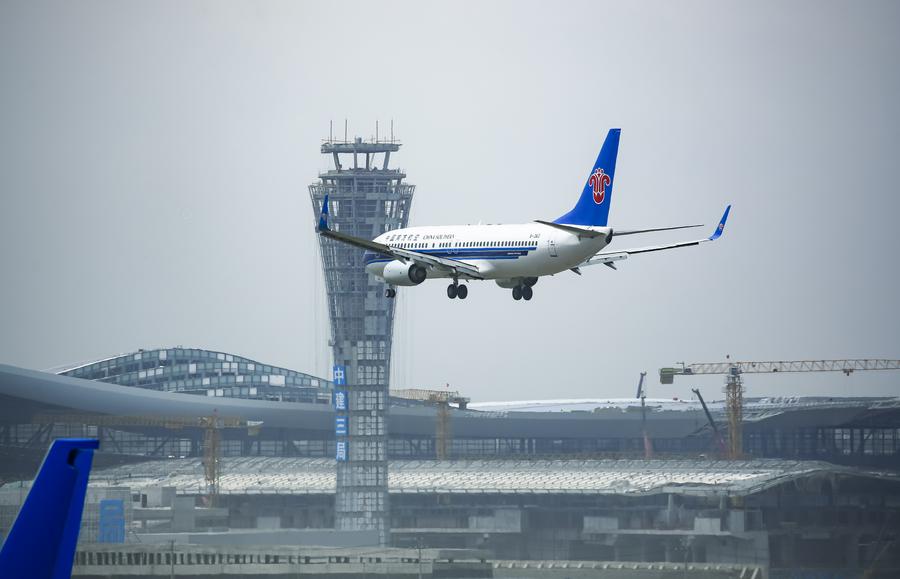Xinjiang airports expand routes, boost cargo traffic
In the first half of this year, northwest China's Xinjiang Uygur Autonomous Region opened eight international cargo air routes, with international cargo volume reaching 47,400 tonnes, seven times higher than the same period last year.
At 5:23 a.m. on July 27, an all-cargo freighter from France's CMA CGM Air Cargo lifted off from the Urumqi Tianshan International Airport, carrying 57 tonnes of cross-border e-commerce goods bound for Paris and Madrid. The flight marked the official launch of a regular Urumqi-Paris/Madrid international cargo route.

This photo taken on May 5, 2023, shows a view of the Urumqi Diwopu International Airport, which is undergoing reconstruction and expansion, in Urumqi, northwest China's Xinjiang Uygur Autonomous Region. (Photo by Wang Zichen/Xinhua)
Currently, Xinjiang Airport Group operates 36 international cargo air routes, covering 21 countries across Asia and Europe. In the first half of this year, 2,574 international cargo charter flights took off from Xinjiang, about six times more than the same period last year.
Why are airlines launching international routes through Xinjiang?
Sitting at the hinterland of the Eurasian continent, Xinjiang enjoys a unique geographic advantage.
"A freighter from Guangzhou, south China's Guangdong Province to Ethiopia takes nearly 11 hours, but from Urumqi, the flight takes just 8 hours. A round trip can save more than 1 million yuan (about $139,248)," said Wu Guofei, strategic development director at Ethiopian Airlines China.
On April 17, the northern terminal of the Urumqi Tianshan International Airport officially went into service.
"At 500,000 square meters, the new terminal is larger than the three old terminals combined. With 177 aircraft stands, it can handle nearly 1,000 flights a day," said Yang Hongfeng, deputy general manager of Xinjiang Airport Group. Yang noted that the group has invested 467 million yuan to upgrade infrastructure.
"Xinjiang's advantageous location makes cross-border transport cheaper and faster. But the drawback is that we're far from the main sources of goods," explained Shi Jun, chairman of Tianyi International Logistics under Xinjiang Airport Group. After visiting clients in Guangdong, Shi found growing demand for air-rail intermodal transport, which can greatly speed up delivery and reduce costs.
On April 18, the first air-rail intermodal freight train departed from Guangzhou International Port in Guangzhou. Upon arrival in Urumqi, the shipments were seamlessly transferred from rail to air and flown onward to Europe, completing the entire journey in less than a week.
"Compared with road transport, the air-rail intermodal transport between Guangdong and Xinjiang is more than 15 percent faster. And compared with China-Europe freight trains, it cuts transit time by about two-thirds. It's ideal for cross-border e-commerce and urgent orders," said Liu Yang, deputy director of the 95306 freight service platform of China Railway Urumqi Group Co., Ltd.
Liu Min, general manager of a Shenzhen-based international logistics company, noted that cargo flows between Xinjiang and the rest of China are on the rise. Costs have come down, while speed and reliability have improved significantly. In the past, it took five to seven days to move goods from Guangzhou to Urumqi. Now it takes only three—and from Xinjiang, shipments can connect directly to international air routes.
To meet the growing demand for cross-border transport in emerging markets, the company this year launched four new year-round charter routes in Xinjiang. Each month, these routes carry an average of more than 3,000 tonnes of cargo, mainly cross-border e-commerce goods bound for Europe and other destinations. The company has also opened a branch office in Xinjiang.
Recognizing the bright prospects of Xinjiang's foreign trade, Tan Deyi, who has worked in the logistics sector in Xinjiang for over a decade, founded an international freight forwarding company. The company handles customs clearance for more than 100 tonnes of cargo every day, with shipments coming mainly from east and south China.
Data from Urumqi Customs shows that in the first half of this year, Xinjiang's trade with Belt and Road Initiative partner countries reached 237.59 billion yuan, up 17.9 percent year on year.
Photos
Related Stories
- Horgos in Xinjiang brings border crossing into daily life
- China's Xinjiang holds intangible cultural heritage exhibition
- View of Tuancheng of Hotan City, China's Xinjiang
- Ancient Kuqa in NW China's Xinjiang sees cultural tourism boom
- Hami melons now available year-round thanks to intelligent platform
- View of wetlands in China's Xinjiang
- Pic story: director of power supply station in Zhaosu County, China's Xinjiang
- In pics: Wuluwat water conservancy project in China's Xinjiang
- Kunlun Mountains scenic area in NW China's Xinjiang attracts visitors during summer vacation
- Intangible heritage aroma in Xinjiang: Experience crafting nang in Hami's ancient streets
Copyright © 2025 People's Daily Online. All Rights Reserved.









